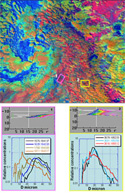|
 |
|
The SOAR research
aircraft flight track superimposed on the
satellite imagery available during the time
that the flight was conducted on 7th February
2005 in the central California (Sierra Nevada)
area.
Click image for more |
Studies conducted by Rosenfeld (1999, 2000) using
satellite data reveal qualitative evidence suggesting
that industrial plumes change the composition of CCN
in such a way as to have an adverse effect on
precipitation processes downwind of industrial
centers. A later study by Borys et al. (2003) would
lend credence to these findings by quantifying
decreases of up to 50% in orographic snowfall rates
over Colorado due to the addition of tiny
anthropogenic sulfate aerosols. Building off of
Borys’s work, Givati and Rosenfeld (2004) constructed
trend analyses of rain gauges downwind of industrial
centers in California and Israel to ascertain the
effect of concentrated plumes of tiny CCN on
orographic precipitation formation. After comparing
the long-range trends of rainfall upwind of the
mountainous regions to rain gauge trends in situ of
orographically favored regions for precipitation it
was found that regions along the coast experienced
static to even positive trends in precipitation
whereas those regions downwind of industrial centers
experienced negative trends relative to the upwind
stations. During the same time period, it was found
that although air pollution is decreasing in these
regions, the production of very small CCN is
increasing due to factors such as greater diesel
consumption among others. Further substantiating the
causative evidence is the observation that no such
difference in rainfall trends were seen in high
elevation rain gauge data downwind of pristine areas
devoid of large industrial centers.
The SOAR research crew participated in a field program
in California during February and March of 2005 (SUPRECIP).
The focus of this project was the overall
investigation of the effect of pollution on Sierra
Nevada winter precipitation, specifically, the nature
and source of the pollutants that are apparently
decreasing the orographic component of the
precipitation over the portions of the Sierra Nevada
that are climatologically downwind of known pollution
sources such as the San Francisco/Oakland/San Jose
Metropolis. The pollution aerosols are apparently tiny
cloud condensation nuclei (CCN) that result in a very
narrow drop spectrum of small drops that inhibits
precipitation-forming processes, especially the riming
of ice crystals in the clouds. The number, sizes and
concentrations of ingested aerosols and the resulting
internal cloud microphysical structure can be
documented by in-cloud measurements.
|